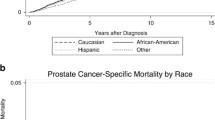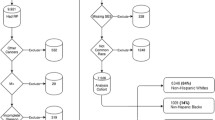Abstract
Purpose
Racial differences in prostate cancer treatment patterns have motivated concerns about over- and undertreatment. We surveyed black and white patients with localized prostate cancer (LPC) regarding their treatment decision-making processes to gain a better perspective on factors associated with LPC treatment choice.
Methods
We conducted a population-based, cross-sectional survey of 260 men (132 black, 128 white) aged ≤75 years, with newly diagnosed LPC. Our primary outcome was treatment choice (either surgery, radiation, or watchful waiting/active surveillance (WW/AS)), and our primary predictors were race and tumor risk level.
Results
Overall, treatment choice did not differ by race. As cancer risk increased, both black and white patients were more likely to undergo surgery and less likely to receive radiation. However, the pattern of WW/AS was different between white and black men. White men were less likely to select WW/AS as cancer risk increased, while risk level was unrelated to black men undergoing WW/AS. Urologist’s recommendation had the greatest impact on men’s treatment choice, followed by tumor risk level, age, and personal preferences.
Conclusions
Although there were no overall racial differences in treatment choice, when stratified by tumor risk level, the pattern of WW/AS was different between white and black patients, suggesting that over- and undertreatment is a larger concern for black than white men. A risk-stratified approach to understand racial disparities in LPC treatment and better strategies to aid black men in their treatment decision-making are needed to reduce racial disparities in prostate cancer outcomes.


Similar content being viewed by others
References
Siegel R, Ward E, Brawley O, Jemal A. Cancer statistics, 2011: the impact of eliminating socioeconomic and racial disparities on premature cancer deaths. CA: Cancer J Clin. 2011;61(4):212–36.
Barocas DA, Penson DF. Racial variation in the pattern and quality of care for prostate cancer in the USA: mind the gap. BJU Int. 2010;106(3):322–8.
Optenberg SA, Thompson IM, Friedrichs P, Wojcik B, Stein CR, Kramer B. Race, treatment, and long-term survival from prostate cancer in an equal-access medical care delivery system. JAMA. 1995;274(20):1599–605.
Underwood 3rd W, Wei J, Rubin MA, Montie JE, Resh J, Sanda MG. Postprostatectomy cancer-free survival of African Americans is similar to non-African Americans after adjustment for baseline cancer severity. Urol Oncol. 2004;22(1):20–4.
Schwartz K, Powell IJ, Underwood 3rd W, George J, Yee C, Banerjee M. Interplay of race, socioeconomic status, and treatment on survival of patients with prostate cancer. Urology. 2009;74(6):1296–302.
Shavers VL, Brown ML, Potosky AL, Klabunde CN, Davis WW, Moul JW, et al. Race/ethnicity and the receipt of watchful waiting for the initial management of prostate cancer. J Gen Intern Med. 2004;19(2):146–55.
Schapira MM, McAuliffe TL, Nattinger AB. Treatment of localized prostate cancer in African-American compared with Caucasian men. Less use of aggressive therapy for comparable disease. Med Care. 1995;33(11):1079–88.
Krupski TL, Kwan L, Afifi AA, Litwin MS. Geographic and socioeconomic variation in the treatment of prostate cancer. J Clin Oncol. 2005;23(31):7881–8.
Zeliadt SB, Moinpour CM, Blough DK, Penson DF, Hall IJ, Smith JL, et al. Preliminary treatment considerations among men with newly diagnosed prostate cancer. Am J Manag Care. 2010;16(5):e121–30.
Cooperberg MR, Broering JM, Carroll PR. Time trends and local variation in primary treatment of localized prostate cancer. J Clin Oncol. 2010;28(7):1117–23.
Ganz PA, Barry JM, Burke W, Col NF, Corso PS, Dodson E, et al. National Institutes of Health State-of-the-Science Conference: role of active surveillance in the management of men with localized prostate cancer. Ann Intern Med. 2012;156(8):591–5.
Presley CJ, Raldow AC, Cramer LD, Soulos PR, Long JB, Yu JB, et al. A new approach to understanding racial disparities in prostate cancer treatment. J Geriatr Oncol. 2013;4(1):1–8.
The US Preventive Serivice Task Force. Screening for prostate cancer. 2012. http://www.uspreventiveservicestaskforce.org/prostatecancerscreening.htm. Accessed 10/10/2013.
Zeliadt SB, Ramsey SD, Penson DF, Hall IJ, Ekwueme DU, Stroud L, et al. Why do men choose one treatment over another?: a review of patient decision making for localized prostate cancer. Cancer. 2006;106(9):1865–74.
Xu J, Dailey RK, Eggly S, Neale AV, Schwartz KL. Men’s perspectives on selecting their prostate cancer treatment. J Natl Med Assoc. 2011;103(June):468–78.
Xu J, Neale AV, Dailey RK, Eggly S, Schwartz KL. Patient perspective on watchful waiting/active surveillance for localized prostate cancer. J Am Board Fam Med : JABFM. 2012;25(6):763–70.
Dillman D. Mail and telephone surveys. New York: John Wiley and Sons Inc.; 1978.
Thompson I, Thrasher JB, Aus G, Burnett AL, Canby-Hagino ED, Cookson MS, et al. Guideline for the management of clinically localized prostate cancer: 2007 update. J Urol. 2007;177(6):2106–31.
D’Amico AV, Whittington R, Malkowicz SB, Schultz D, Blank K, Broderick GA, et al. Biochemical outcome after radical prostatectomy, external beam radiation therapy, or interstitial radiation therapy for clinically localized prostate cancer. JAMA. 1998;280(11):969–74.
Charlson ME, Pompei P, Ales KL, MacKenzie CR. A new method of classifying prognostic comorbidity in longitudinal studies: development and validation. J Chron Dis. 1987;40(5):373–83.
Hoffman RM, Harlan LC, Klabunde CN, Gilliland FD, Stephenson RA, Hunt WC, et al. Racial differences in initial treatment for clinically localized prostate cancer. Results from the prostate cancer outcomes study. J Gen Intern Med. 2003;18(10):845–53.
Underwood W, De Monner S, Ubel P, Fagerlin A, Sanda MG, Wei JT. Racial/ethnic disparities in the treatment of localized/regional prostate cancer. J Urol. 2004;171(4):1504–7.
Steenland K, Goodman M, Liff J, Diiorio C, Butler S, Roberts P, et al. The effect of race and rural residence on prostate cancer treatment choice among men in Georgia. Urology. 2011;77(3):581–7.
Denberg TD, Beaty BL, Kim FJ, Steiner JF. Marriage and ethnicity predict treatment in localized prostate carcinoma. Cancer. 2005;103(9):1819–25.
Moses KA, Paciorek AT, Penson DF, Carroll PR, Master VA. Impact of ethnicity on primary treatment choice and mortality in men with prostate cancer: data from CaPSURE. J Clin Oncol. 2009;28(6):1069–74.
Fowler Jr FJ, McNaughton Collins M, Albertsen PC, Zietman A, Elliott DB, Barry MJ. Comparison of recommendations by urologists and radiation oncologists for treatment of clinically localized prostate cancer. JAMA. 2000;283(24):3217–22.
Hamilton AS, Albertsen PC, Johnson TK, Hoffman R, Morrell D, Deapen D, et al. Trends in the treatment of localized prostate cancer using supplemented cancer registry data. BJU Int. 2011;107(4):576–84.
Barocas DA, Cowan JE, Smith Jr JA, Carroll PR. What percentage of patients with newly diagnosed carcinoma of the prostate are candidates for surveillance? An analysis of the CaPSURE database. J Urol. 2008;180(4):1330–4.
Davison BJ, Goldenberg SL. Patient acceptance of active surveillance as a treatment option for low-risk prostate cancer. BJU Int. 2011;108(11):1787–93.
Cooperberg MR, Broering JM, Kantoff PW, Carroll PR. Contemporary trends in low risk prostate cancer: risk assessment and treatment. J Urol. 2007;178(3 Pt 2):S14–9.
Wilt TJ, Brawer MK, Jones KM, Barry MJ, Aronson WJ, Fox S, et al. Radical prostatectomy versus observation for localized prostate cancer. N Engl J Med. 2012;367(3):203–13.
Acknowledgments
This study was supported by a Mentored Research Scholar Grant in Applied and Clinical Research (Grant #MRSGT-06-133-01-CPPB) from American Cancer Society.
Conflict of Interest
All authors declare that they have no conflict of interest.
Informed Consent
All procedures followed were in accordance with the ethical standards of the responsible committee on human experimentation (institutional and national) and with the Helsinki Declaration of 1975, as revised in 2000 (5). The study received approval from the institutional review board at Wayne State University. A waiver of written consent was granted and an information sheet was mailed with each survey.
Author information
Authors and Affiliations
Corresponding author
Rights and permissions
About this article
Cite this article
Xu, J., Janisse, J., Ruterbusch, J. et al. Racial Differences in Treatment Decision-Making for Men with Clinically Localized Prostate Cancer: a Population-Based Study. J. Racial and Ethnic Health Disparities 3, 35–45 (2016). https://doi.org/10.1007/s40615-015-0109-8
Received:
Revised:
Accepted:
Published:
Issue Date:
DOI: https://doi.org/10.1007/s40615-015-0109-8




